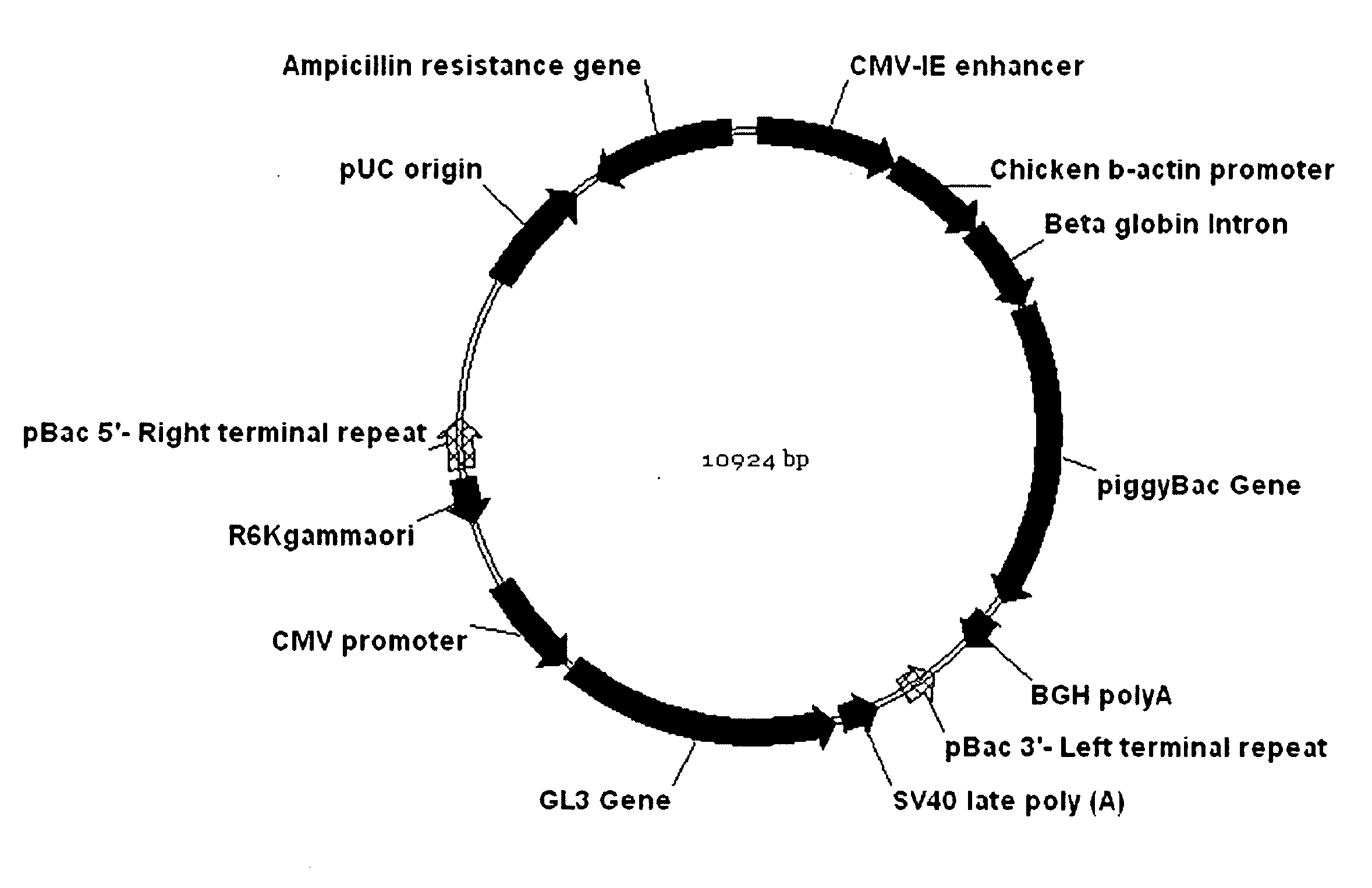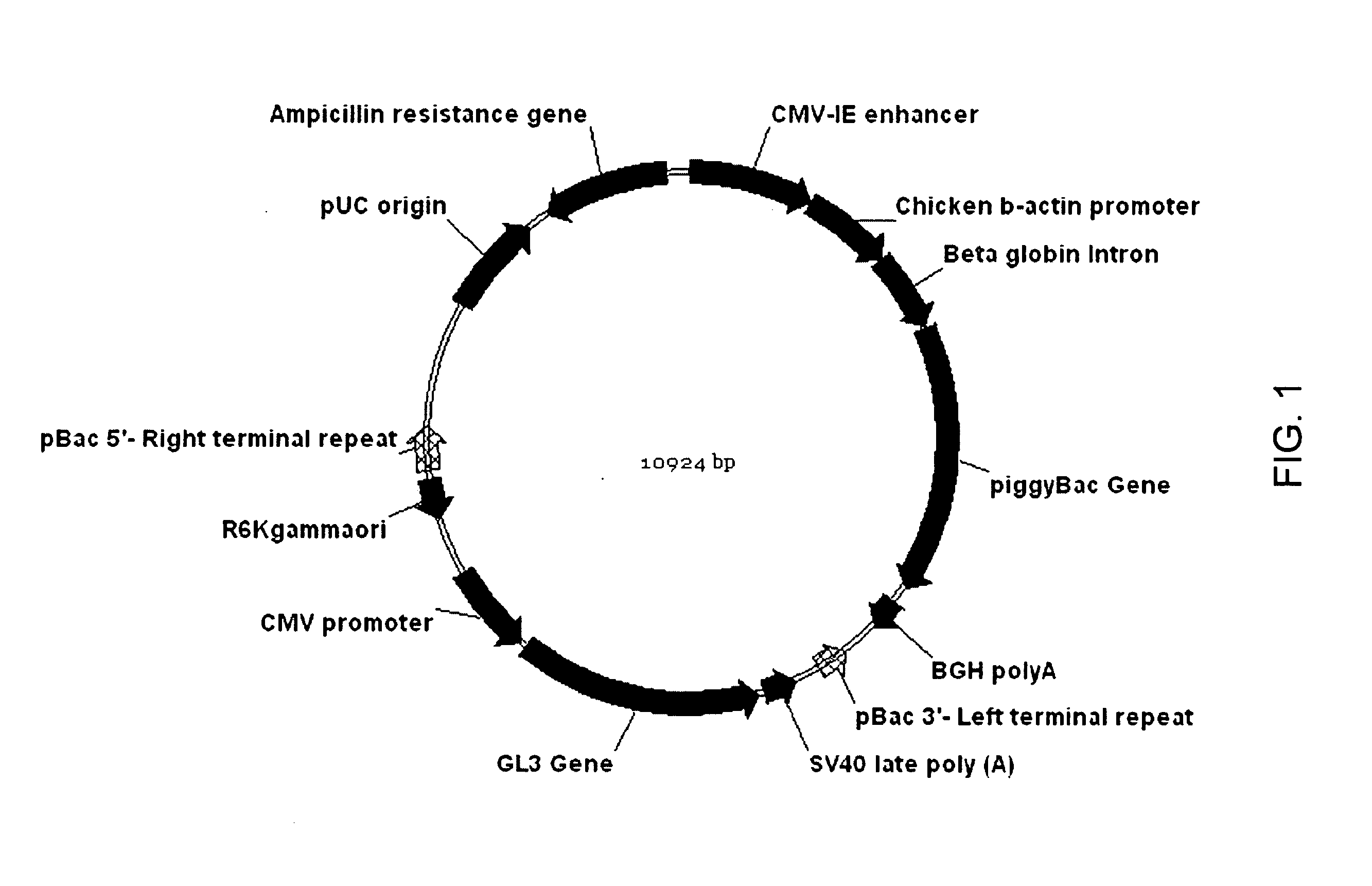Methods and compositions for targeted delivery of gene therapeutic vectors
- Summary
- Abstract
- Description
- Claims
- Application Information
AI Technical Summary
Benefits of technology
Problems solved by technology
Method used
Image
Examples
example 2
Verification of Genomic Insertion of a PiggyBac Transgene Following Microbubble Delivery of the PiggyBac Insertional Plasmid
[0141]A version of the plasmid DH2pGL3 is prepared in which a kanamycin antibiotic resistance gene and bacterial origin of replication are located within the piggyBac transposon region, along with the GL3 gene, between the two terminal repeats utilized by the piggyBac transposase. Microbubble delivery of the plasmid to heart and liver tissue (in separate mice) is performed as described in Example 1. After 30 days, the mice are killed, their hearts or livers (as appropriate) removed, homogenized in buffer, and genomic DNA is recovered and assayed for gene insertion. This is achieved by digesting the genomic DNA with a restriction enzyme for which there is no cleavage site within the piggyBac transposon of DH2pGL3. The digested DNA is then religated and transformed into bacteria, which is then cultured in the presence of the antibiotic kanamycin. Bacteria that ha...
example 3
[0142]Microbubble Delivery of a PiggyBac Insertional Plasmid to Liver tissue in Mice
[0143]Tissue-specific delivery of a luciferase reporter gene to the liver in mice is performed using the procedure of Example 1. Plasmid DH2pGL3 and the control plasmid SV40pGL3 are each combined with perfluorocarbon gas-filled cationic microbubbles as described in the previous example, and infusion of mice with the mixture is performed as described. In this case, ultrasound is directed at mice livers to disrupt the microbubbles and deliver the test plasmid to this location. After 2 or 28 days, the mice are killed, and their livers removed, homogenized and processed as described for hearts in Example 1 to assay for luciferase expression using the luciferase assay system (Promega). As observed for hearts, expression of luciferase in DH2pGL3-treated mice is observed after 2 days at levels significantly higher than observed in livers from mice treated with the SV40pGL3 control plasmid. Activity is also ...
example 4
Microbubble Delivery of a PiggyBac Insertional Plasmid to Retinal Tissue in Mice
[0144]Tissue-specific delivery of a luciferase reporter gene to retinal cells in mice is performed using the procedure of Example 1. Plasmid DH2pGL3 and the control plasmid SV40pGL3 are each combined with perfluorocarbon gas-filled cationic microbubbles as described in the previous example, and infusion of mice with the mixture is performed as described. In this case, ultrasound is directed at retinal tissue in mice to disrupt the microbubbles and deliver the test plasmid to this location. After 2 or 28 days, the mice are anesthetized and injected with 150 mg per kg animal weight of luciferin (the substrate for firefly luciferase). Luciferase activity in the retina is then assayed by directly measuring luminescence in the eyes using an IVIS imaging system (Xenogen). Retinal expression of luciferase is higher after 2 days in mice treated with DH2pGL3 than in mice treated with the SV40pGL3 control plasmid....
PUM
 Login to View More
Login to View More Abstract
Description
Claims
Application Information
 Login to View More
Login to View More - R&D
- Intellectual Property
- Life Sciences
- Materials
- Tech Scout
- Unparalleled Data Quality
- Higher Quality Content
- 60% Fewer Hallucinations
Browse by: Latest US Patents, China's latest patents, Technical Efficacy Thesaurus, Application Domain, Technology Topic, Popular Technical Reports.
© 2025 PatSnap. All rights reserved.Legal|Privacy policy|Modern Slavery Act Transparency Statement|Sitemap|About US| Contact US: help@patsnap.com



